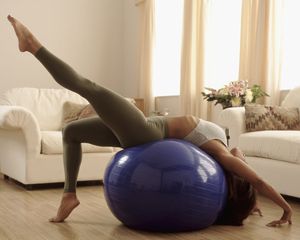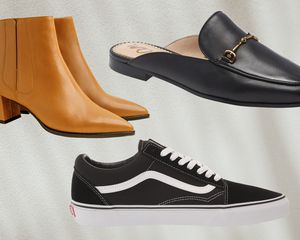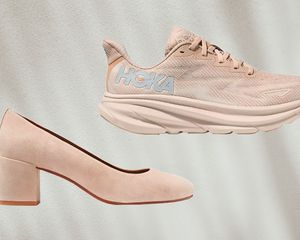:max_bytes(150000):strip_icc()/Stocksy_txp94aecbd7xr3300_Medium_703384-d6bd7f1c925f4012a70b4afc7d91f982.jpg)
JOVELL RENNIE / Stocksy
Ballerinas have a way of carrying themselves with grace, strength, and confidence. Their training not only teaches them poise but also works their bodies in a way that creates long and lean muscles. You, too, can train like a ballerina (minus the bruised toes and fierce competition) with these ballet exercises that will sculpt and strengthen your entire body. “It’s a method of movement that allows you to connect to the body, to sculpt a feminine physique, to balance posture, and to burn calories without heavy impact,” says Christine Bullock, former ballerina, and creator of Evolution 20.
Ballet dancer and director of the Steezy Studio Brittany Cavaco agrees, adding that ballet gives you strength, flexibility, coordination, endurance, and lots of energy. “I find that even doing just 20 minutes of a ballet barre or ballet toning class gives me a lot of mental clarity,” she says. “The repetition of the movements, along with the artistry, allows you to do a full-body workout without even realizing it.”
Ready to get started? Here are 10 total-body exercises to get you a toned physique like a ballet dancer’s.
Meet the Expert
- Brittany Cavaco is a professional ballet dancer and the director of the Steezy Studio ballet program. Her career highlights include dancing with companies such as the Washington Ballet, Los Angeles Ballet, and English National Ballet.
- Christine Bullock is a former ballerina, a fitness expert, and the creator of the Evolution 20, Super Shred, and Body Reborn fitness series, as well as the co-creator of Kayo Body Care. She is certified in yoga, Pilates, postnatal fitness, and nutritional counseling.
Safety and Precautions
These ballet exercises are low-impact, so they are easy on your joints and also strengthen your muscles to prevent injury. “These ballet-inspired toning moves are very inclusive,” says Cavaco. Even so, it is important to check in with your doctor before starting a new exercise program, especially if you have existing health conditions such as heart disease, diabetes, or high blood pressure.
Start slowly with any exercise program, stopping if you have any pain, and work your way up in intensity and duration. If you have prior injuries or conditions like arthritis, Cavaco recommends listening to your body and stopping if you have any discomfort. “I would suggest that people with arthritis take the pliés very slow and don’t go as deep down.”
One of the benefits of ballet toning and ballet barre exercises is that they can help prevent future injuries. “Even if you love heavy weights or HIIT workouts, it’s beneficial to your body and goals to add barre,” says Bullock. “This type of workout can build the small muscles around joints to protect from injury. It incorporates mobility and flexibility to balance posture and sculpt longer musculature, and it still blasts calories.”
Plié in First Position
Steezy Studio
Plié means “to bend,” and it is the best exercise for your glutes and legs. “This traditional ballet exercise is the first step we do in every ballet class, and it is the bread and butter of all ballet moves,” says Cavaco. There are two types of pliés: a demi plié (meaning small or half) and a grand plié (meaning big or full). She recommends doing each type of plié in this exercise sequence.
- Start with a demi plié in first position. Your heels should be touching and your toes pointed outward.
- Your legs will be straight to start, glutes engaged, and pelvis slightly tucked.
- Bend your knees, going down about halfway, with your heels still on the floor.
- You will create a diamond shape with your legs. This is your demi plié.
- To do a grand plié, just continue all the way down until your glutes are hovering over your heels.
- In between each plié, come back up to straight legs.
- Perform three demi pliés followed by one grand plié. Repeat this sequence for three to five sets.
Byrdie Tip
“Try to keep your pelvis and glutes under you. It’s tempting to let them go back like a squat, but try to avoid that if possible,” says Cavaco. “Also, make sure to have your knees go over your first and second toes in each plié to avoid any knee discomfort.”
Plié in Second Position
Steezy Studio
This is the same exercise as the first position plié, however, you will be standing in what ballerinas call the second position. You will also perform both the demi plié and the grand plié (pictured above) in this sequence.
- Stand in second position, with your feet hip-distance apart and your toes turned out.
- Perform the demi plié, in which you go halfway down.
- Return to standing.
- To perform the grand plié, bring your pelvis in line with your knees. Your heels should stay on the ground.
- Perform three demi pliés followed by one grand plié. Repeat this sequence for three to five sets.
Jeté
Steezy Studio
“This will ignite your inner thighs,” says Cavaco, who explains that “jeté” means “to throw.”
- Start in fifth position, with both feet turned out and one in front of the other. Your front foot’s heel should touch the back foot’s toe.
- Your outside leg will go out to the side at 45 degrees and then close in fifth position, with this leg in the back instead of the front.
- Continue doing this movement, alternating front and back.
- Repeat on the other leg.
- Do as many repetitions as you can for one minute.
Byrdie Tip
“Make sure that both legs stay as straight as possible the entire time,” says Cavaco.
Leg Circles
Steezy Studio
This exercise strengthens and sculpts your abdominal muscles. The bigger the circle, the more challenging it will be!
- Sit tall on your sitz bones (the bony part of your pelvis), and lean back onto your hands behind you.
- Bring your legs up to tabletop and have them glued together.
- Circle your legs around, starting to the right.
- Do this 15 times, then repeat to the left.
Bridging
Steezy Studio
Bridging helps lift and strengthen your bum as it works your gluteus muscles, hamstrings, and even your core.
- Lay on the ground, with your head facing toward the ceiling.
- Place your feet hip-distance apart, with your knees pointing to the ceiling.
- Engage your lower abdominals, and start the movement by tucking your pelvis.
- Slowly roll up into a high bridge, lifting each vertebra in your back one by one.
- When you reach the top, hold for a moment, and slowly reverse down. Make sure that your hips are even throughout the exercise.
- Perform 20–40 reps.
Standing Obliques
Steezy Studio
This exercise tones and sculpts your oblique muscles, which are your side abdominal muscles. “Try not to let momentum take you up, and instead let it be driven by your muscles,” says Cavaco.
- Stand up, feet hip-distance apart. Make sure your shoulders, hips, and feet are all in the same line.
- Put your hands over your head.
- Lean to the right, and use your left oblique to slowly bring yourself back up.
- Repeat 20–30 times on each side.
Ballet Arms
Steezy Studio
You know how ballerinas have such beautiful arms? It is partly due to this move, which also strengthens your shoulder and back muscles.
- Standing hip-distance apart, open your arms to your sides. Make sure your elbows are lifted and your forearms are curved in slightly.
- Using your lats and back muscles, bring your arms together in front of you. Imagine that you are hugging a tree.
- Reverse your arms back out.
- Make sure not to let your elbows drop and to keep your arms at shoulder height throughout the entire exercise.
- Repeat this move for 30 seconds to one minute.
Plank With Hip Dips
Steezy Studio
This exercise strengthens and tones your midsection, giving you that lean and graceful look of a ballerina.
- Start in a plank position, with your hands directly under your shoulders.
- Try to keep your body as long and straight as possible, from your head to your toes. Make sure your bottom isn’t sticking up.
- Engage your lower abdominals, and shift your hips to one side. Come back to the middle, and then shift them to the other side.
- Lift your shoulders up and out throughout the entire exercise.
- Repeat 15 hip dips on each side.
Inner-Thigh Lifts
Steezy Studio
This thigh-lift exercise will strengthen and tone your inner-thigh muscles for strong and sculpted dancer’s legs.
- Lie down on your side, and take your top leg and bring it over onto the floor in front of you.
- Flex your bottom foot, lift it up about seven inches, and then lower it back down.
- Lift it high enough so you are feeling your muscle work. If you aren’t feeling it, you aren’t lifting your leg high enough.
- Perform 30–40 reps on each side.
The Swan
Steezy Studio
“The goal here is to look like a beautiful swan,” says Cavaco. “Let your arms be engaged, but not stiff.”
- Stand hip-distance apart, with your hands by your hips.
- Let your elbows lead your arms as they travel up above your head and then come back down.
- Make sure not to let your shoulders creep up toward your ears, and avoid any tension in your head, neck, or chest.
- Repeat this move for 30 seconds to one minute.




